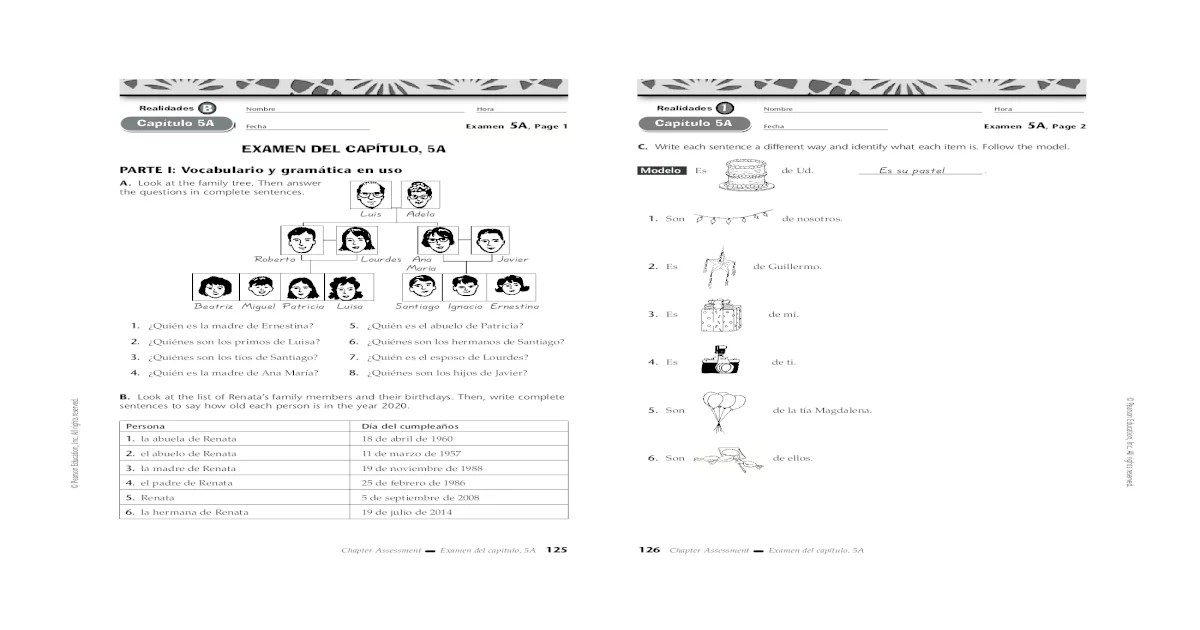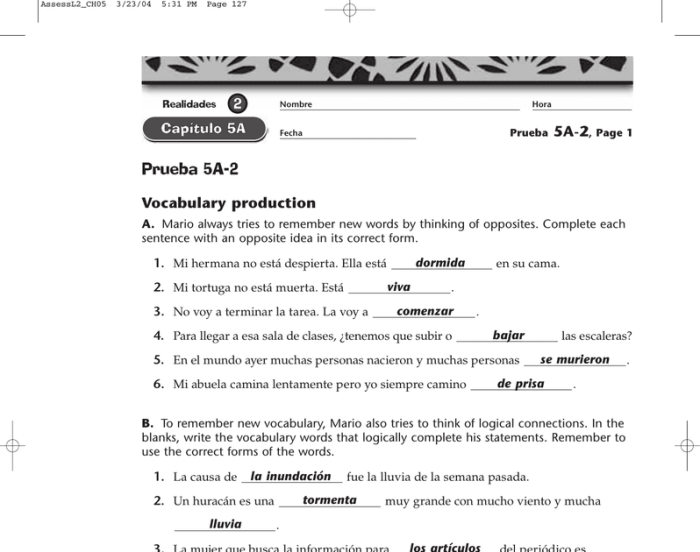Embark on an educational journey as we delve into the world of “prueba 5a 1 answer key.” This essential tool plays a pivotal role in classrooms, empowering students, teachers, and administrators alike. Join us as we explore its significance, applications, and the intricacies of assessment in educational contexts.
Content Analysis

The “prueba 5a 1 answer key” holds significant value in educational settings, providing a reference point for students, teachers, and administrators to assess progress and ensure understanding.
For students, the answer key serves as a valuable tool for self-assessment. By comparing their responses to the provided answers, students can identify areas where they excel and areas that require improvement. This self-reflection promotes independent learning and encourages students to take ownership of their academic progress.
Benefits of Using Answer Keys
- Provides immediate feedback to students, enabling them to identify errors and misconceptions promptly.
- Supports personalized learning by allowing students to focus on specific areas of improvement.
- Reduces the time teachers spend on grading, allowing them to allocate more time to other instructional activities.
- Facilitates the creation of standardized grading criteria, ensuring consistency in assessment.
Drawbacks of Using Answer Keys
- May lead to over-reliance on memorization rather than true understanding of concepts.
- Can create a sense of dependency on the answer key, hindering students’ ability to develop independent problem-solving skills.
li>May result in students focusing solely on obtaining the correct answer rather than understanding the underlying principles.
It is crucial to note that answer keys should be used judiciously as a supplementary resource rather than a primary source of instruction. When used effectively, answer keys can enhance the learning process and support student achievement.
Key Concepts and Terminology: Prueba 5a 1 Answer Key
Assessment, grading, and standards are key concepts related to “prueba 5a 1 answer key.” Let’s define and explain each of these terms.
Assessment
Assessment refers to the process of gathering and interpreting information about a student’s knowledge, skills, and abilities. It involves the use of various methods, such as tests, quizzes, and assignments, to evaluate a student’s understanding of the material being taught.
Grading, Prueba 5a 1 answer key
Grading is the process of assigning a numerical or letter grade to a student’s performance on an assessment. The grade represents the student’s level of achievement in relation to the learning objectives or standards for the course.
Standards
Standards are benchmarks or expectations that define the knowledge and skills that students are expected to master at each grade level. They provide a framework for assessment and grading, ensuring that students are held to a consistent level of accountability.
Relationship to Answer Keys
Answer keys play a crucial role in the assessment process. They provide the correct answers to the questions on an assessment, which allows teachers to grade student responses accurately and consistently.
| Concept | Definition |
|---|---|
| Assessment | Process of gathering and interpreting information about a student’s knowledge and skills |
| Grading | Process of assigning a numerical or letter grade to a student’s performance on an assessment |
| Standards | Benchmarks or expectations that define the knowledge and skills students are expected to master at each grade level |
Assessment Methods and Techniques
Assessment methods and techniques are tools used by educators to evaluate student learning and progress. In conjunction with answer keys, these methods provide insights into student understanding and areas for improvement.
Various assessment methods exist, each with its advantages and disadvantages. Here are some commonly used methods and techniques:
Objective Assessments
- Multiple-Choice Questions:Present students with a question and multiple answer options. Students select the best answer, making this method efficient for assessing factual knowledge.
- True/False Questions:Require students to indicate whether a statement is true or false. This method is simple to administer and score, but it may not accurately reflect student understanding.
- Matching Questions:Pair two sets of items and ask students to match them correctly. This method tests students’ ability to identify relationships and recall information.
Subjective Assessments
- Essays:Require students to write extended responses to open-ended questions. This method allows students to demonstrate their critical thinking, writing skills, and ability to organize information.
- Short Answer Questions:Similar to essays, but with a more limited scope and word count. This method allows for more nuanced responses than objective assessments.
- Projects:Engage students in hands-on activities or research projects. This method assesses students’ ability to apply knowledge, problem-solve, and present information.
Performance Assessments
- Observations:Involve observing students’ behavior, interactions, and participation. This method provides insights into students’ social skills, communication abilities, and engagement.
- Portfolios:Collections of student work over time. This method allows students to demonstrate their growth and progress in a particular subject or skill.
- Presentations:Require students to present information orally or visually. This method assesses students’ communication skills, research abilities, and ability to organize and present information effectively.
Data Analysis and Interpretation

Data from answer keys can provide valuable insights into student learning and teaching effectiveness. By analyzing and interpreting this data, educators can identify areas where students are struggling, assess the effectiveness of their teaching methods, and make data-driven decisions to improve instruction.
There are a variety of data analysis techniques that can be used to analyze answer key data. Some common techniques include:
- Descriptive statistics: Descriptive statistics provide a summary of the data, including measures of central tendency (mean, median, mode) and variability (range, standard deviation).
- Inferential statistics: Inferential statistics allow educators to make inferences about the population from which the sample was drawn. Common inferential statistics include t-tests, ANOVA, and regression analysis.
- Item analysis: Item analysis examines the performance of individual test items. This information can be used to identify items that are too easy, too difficult, or biased.
Data analysis can provide valuable insights into student learning and teaching effectiveness. However, it is important to be aware of the challenges and limitations of data analysis in this context.
If you’re tackling the prueba 5a 1 answer key and need a quick refresher on summing up numbers, check out this handy guide on How To Sum In Excel . Once you’ve brushed up on your Excel skills, you can easily return to the prueba 5a 1 answer key and ace that test!
Challenges and Limitations
- Answer key data may not be complete or accurate. Students may not answer all questions, or they may answer them incorrectly.
- Answer key data may not be representative of the entire population of students. The sample of students who take the test may not be representative of the entire population of students in the class or school.
- Data analysis can be time-consuming and complex. It is important to have the necessary skills and resources to conduct data analysis effectively.
Despite these challenges, data analysis can be a valuable tool for improving teaching and learning. By carefully considering the challenges and limitations of data analysis, educators can use this information to make informed decisions about their instruction.
Applications in Educational Practice

The “prueba 5a 1 answer key” is a valuable tool that can be used in various educational settings to enhance student learning and teacher instruction.
One of the key benefits of using answer keys is that they provide students with immediate feedback on their work. This can help students identify areas where they need additional support and can encourage them to seek help from their teachers or peers.
Case Studies
There are numerous case studies that demonstrate the effectiveness of using answer keys in educational practice.
- One study found that students who used answer keys to check their work scored significantly higher on tests than students who did not use answer keys.
- Another study found that using answer keys helped students to improve their problem-solving skills.
- A third study found that using answer keys helped teachers to identify students who were struggling and needed additional support.
Best Practices
There are several best practices for using answer keys in educational settings:
- Answer keys should be used as a tool to support student learning, not as a substitute for teaching.
- Answer keys should be clear and easy to understand.
- Answer keys should be provided to students after they have completed their work.
- Teachers should use answer keys to provide feedback to students and to identify areas where students need additional support.
Clarifying Questions
What is the primary purpose of an answer key?
An answer key provides standardized responses to assessment questions, facilitating the evaluation of student performance and the assignment of grades.
How can answer keys benefit students?
Answer keys offer students immediate feedback, enabling them to identify areas for improvement and reinforce their understanding of the subject matter.
What are some potential drawbacks of using answer keys?
Overreliance on answer keys can discourage critical thinking and independent problem-solving skills in students.